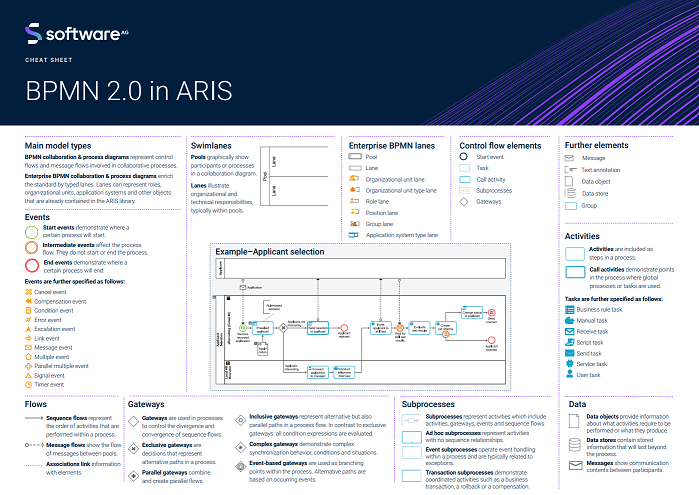First of all a big applause for ARIS: ARIS is now a BPMN 2.0 leader! As one of only three tools, ARIS was able to successfully submit the entire test set of the BPMN Model Interchange Working Group (MIWG) and showed strong capabilities for importing, exporting and roundtripping (http://bpmn-miwg.github.io/bpmn-miwg-tools/).
If you want to read more about the validation and the BPMN 2.0 support in ARIS, I encourage you to read the article "If BPMN 2.0 then BPMN 2.0 in ARIS please!".
BPMN 2.0 in ARIS is unique. Of course ARIS supports the BPMN 2.0 standards. That’s one thing. But ARIS is more than BPMN 2.0 standard. It extends the standard with the business perspective and that what makes it so powerful. Sounds exciting but with so many possibilities do you fear losing track? No worries!
We created a fresh, new BPMN 2.0 in ARIS cheat sheet. You’ll find all important entities and their explanations, including symbols in one single view. We’ve packed it into a handy pdf format which you can download and print to reuse as cheat sheet. The cheat sheet covers all major aspects from model types, lane types, events, gateways, processes, flows, activities and data. It is the perfect guide to help you with the modeling. Click on the picture to download the pdf document.
You think it's good? Then be nice today and share it with your colleagues. I’m sure they will be grateful ;)
ARIS does not only offer great BPMN 2.0 support, ARIS adds DMN 1.2 support with ARIS 10 SR6 in October 2018 – being one of the first worldwide! – and encompasses BPMN modeling into the ARIS process landscapes. Using the process hierarchy und repository of ARIS, you can describe your enterprise from the strategic perspective down to the execution level.
We will go into this in more details and give you some useful tips in our next article – stay tuned!




Hendrik Ohler on
Nice sheet. Thanks